Day 1 of a three day long weekend of Winter Tours in North Norfolk today. It was a nice morning, cloudy with some brighter intervals, but the cloud thickened in the afternoon and brought some misty drizzle with it at times.
Our first stop was at Blakeney. As we set out towards the seawall, a small group of Brent Geese were feeding on the edge of the saltmarsh the other side of the harbour channel. The first half dozen were our regular Dark-bellied Brent Geese but a pair a few metres further on were more interesting. One of the pair was much paler on the flanks and belly. It was a Pale-bellied Brent Goose and it appeared to be paired with a male Dark-bellied Brent. It really stood out next to the Dark-bellieds.
 Pale-bellied Brent Goose – this one is paired with a Dark-bellied Brent
Pale-bellied Brent Goose – this one is paired with a Dark-bellied Brent
Dark-bellied Brent Geese breed in arctic Russia and come here for the winter in large numbers. Pale-bellied Brent Geese breed from Svalbard across Greenland into the Canadian High Arctic. We regularly get a small number of Pale-bellied Brents in with our regular wintering flocks of Dark-bellied Brents.
While we were looking out over the saltmarsh beyond, suddenly lots of birds took to the air. A flock of Golden Plover whirled overhead. Low over the vegetation we picked up a Hen Harrier further back, quartering the marshes. A ringtail, it flashed its white rump patch as it flew away from us.
As we walked out past the harbour, a Rock Pipit flew across and landed on one of the small boats tied up on the water, where we could get it in the scope. We flushed several Meadow Pipits from the grassy banks of the seawall and a few Reed Buntings too. We heard the distinctive calls of a Lapland Bunting flying over, a dry rattle ‘t-t-t-t’ and a ringing ‘teu’, but it was long way out over the grazing marshes and we didn’t manage to find it.
There were various waders which flushed from the saltmarsh as we walked past, Curlews and Redshanks. A Little Egret was busy feeding in one of the channels. A group of Turnstone ran along a path ahead of a couple of dogs until they got too close and the Turnstone flew off towards the channel.
At the corner of the seawall, we stopped to look at a small flock of Dunlin on the edge of the harbour. A smart drake Goldeneye surfaced on the water just behind and then a raft of duck appeared in the channel. As well as a few more Goldeneye, there were several Red-breasted Mergansers with their spiky haircuts. While we were admiring them a rather nondescript brown duck bobbed up in their midst. It was a 1st winter female Scaup, normally difficult to find here in the winter but this appears to be a good year for them.
There were a few more waders here now too. A Ringed Plover and a Grey Plover, both picking at the surface with their short bills. An Oystercatcher too. The tide was starting to go out and more mud was beginning to appear. A little further along the seawall, where the harbour starts to open out, there were some bigger numbers of waders and sifting through them we found a small group of dumpy Knot and a couple of Black-tailed Godwits closer to us. The Bar-tailed Godwits were much further over.
We had seen a female Marsh Harrier earlier, on our walk out, flying over the reeds out in the middle of the Freshes. When all the Wigeon erupted from the grazing marshes, we turned to see a male Marsh Harrier flying towards us. It turned slightly and cut out across the saltmarsh, flying past us and flushing all the Brent Geese as it went.
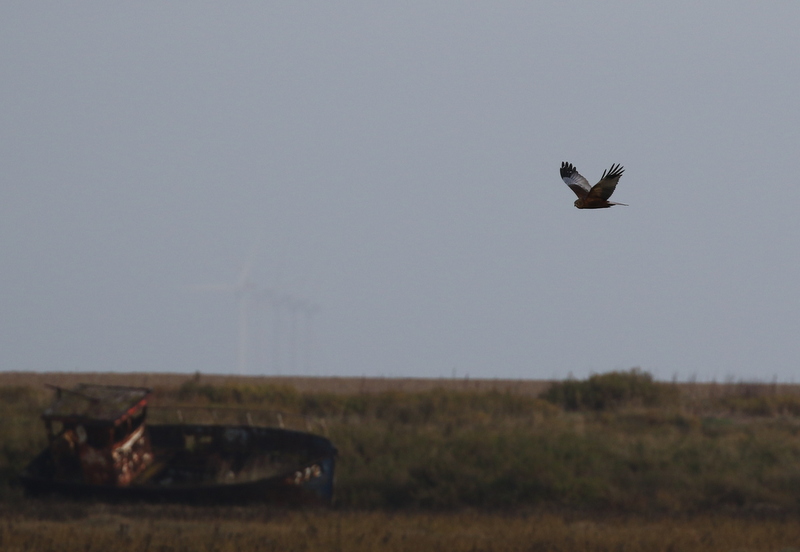 Marsh Harrier – a smart, grey-winged male
Marsh Harrier – a smart, grey-winged male
There were a few Skylarks feeding on the short vegetation on the inland side of the seawall, which flushed as we approached. They circled round and landed again on the edge of an open area. A slightly smaller bird was with them now and through the scope we could confirm it was a Lapland Bunting. It was creeping around in the short grass at first and hard to see, but then it flew a short distance towards us and landed out in the open where we could get a great view of it through the scope.
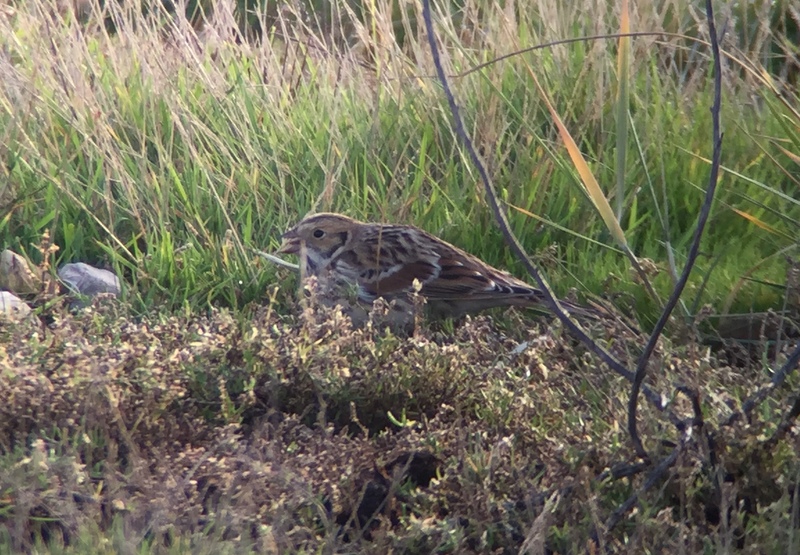 Lapland Bunting – feeding with Skylarks below the seawall
Lapland Bunting – feeding with Skylarks below the seawall
The Skylarks were nervous and kept flying round. The Lapland Bunting also flew around a couple of times and landed back on the short grass. Then suddenly it was off, calling as it went.
Lapland Buntings can be very hard to find out in the open, so this was a great way to cap off our walk here. As we started to walk back, we could see five or six small birds perched on the fence and a closer look confirmed there were five Twite.They had obviously been bathing in the puddles by the path and were now busy preening. We got them in the scope and could see their yellow bills and burnt orange faces.
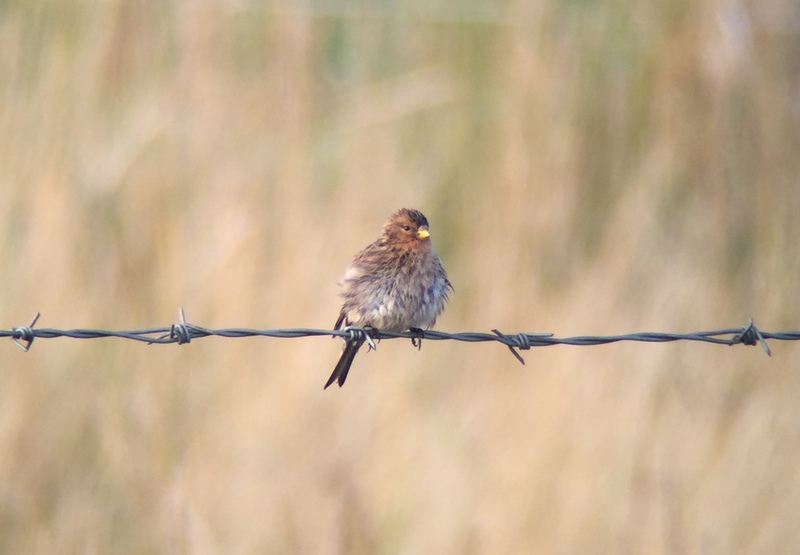 Twite – five were preening on the fence after having a bathe
Twite – five were preening on the fence after having a bathe
The sixth bird was a single Linnet which perched on the fence near the Twite for comparison for a few seconds. We could see it had a grey bill and was not as brightly coloured on the face as the Twite.
Back to the car, and we made our way further east to Salthouse. We parked at the end of Beach Road and walked east along the edge of the shingle towards Gramborough Hill. Local photographers have been putting seed out for the Snow Buntings here, so when a small group of buntings appeared from around the back of the Hill, we initially thought they would be the Snow Buntings. They headed south, inland across the grazing marshes, which would be an odd direction for Snow Buntings to go and when they turned and dropped down, with the fields behind them, we could see they were actually more Lapland Buntings.
There were at least 15 Lapland Buntings in the flock, a very good number, but they kept on going and we lost sight of them as they flew off west. We weren’t finished though, and yet another lone Lapland Bunting circled over the grazing marshes calling a few minutes later before dropping down into the grass out in the middle.
The day’s delivery of seed had just been put out for the Snow Buntings and we didn’t have to wait long before they flew back in to enjoy it. They landed on the top of the shingle ridge first, where they had a good vantage point to check for any danger, before running down the slope to where the food was waiting for them. There were at least forty of them here today, although not all of them came down to feed.
 Snow Buntings – coming down to feed on feed put out on the shingle ridge
Snow Buntings – coming down to feed on feed put out on the shingle ridge
The Snow Buntings can be quite tame and we had great close views of them when they came down to the food. Looking at the flock, we could see a variety of different looking birds, some much paler ones amongst a mass of darker, browner ones. We get two different races here in the winter from different breeding areas. The duller ones are predominantly female Snow Buntings of the Icelandic race, insulae, whereas the paler ones are from Scandinavia, of the race nivalis.
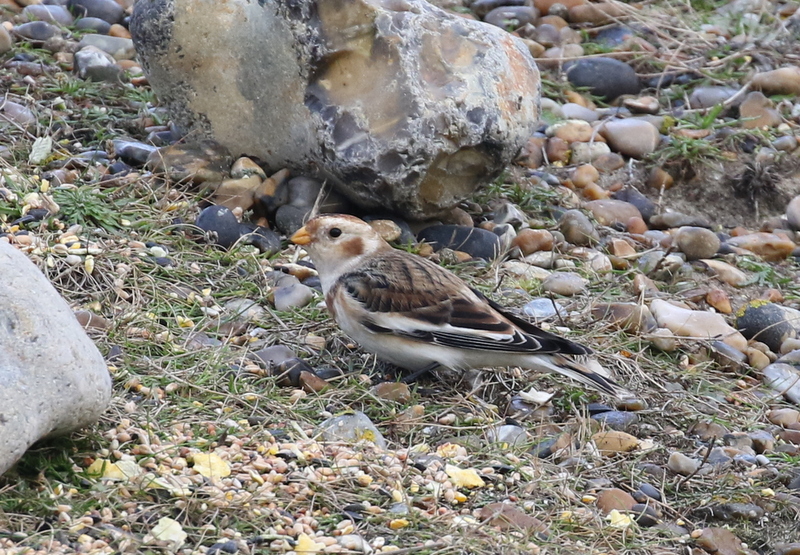 Snow Bunting – of the Scandinavian race, nivalis
Snow Bunting – of the Scandinavian race, nivalis
Regardless of where they come from, the Snow Buntings are always great to watch. Along with Lapland Buntings, they are our two sought after winter buntings, so we had enjoyed a very successful morning getting such great views of both species.
We walked back over Gramborough and along the remains of the now flattened shingle ridge. The sea looked fairly quiet but we did see a loose groups of six Red-throated Divers flying past distantly. Another Red-throated Diver was on the sea, along with a single Guillemot, but both were hard to see out in the swell and diving constantly. A couple of Grey Seals surfaced just offshore and were much more obliging – they seemed to come in to investigate a couple of fishermen down on the beach. Back to the car and a very obliging group of Turnstones had flown in to feed on some food put out for them. We watched them feverishly turning the stones over – they had a lot to choose from here!
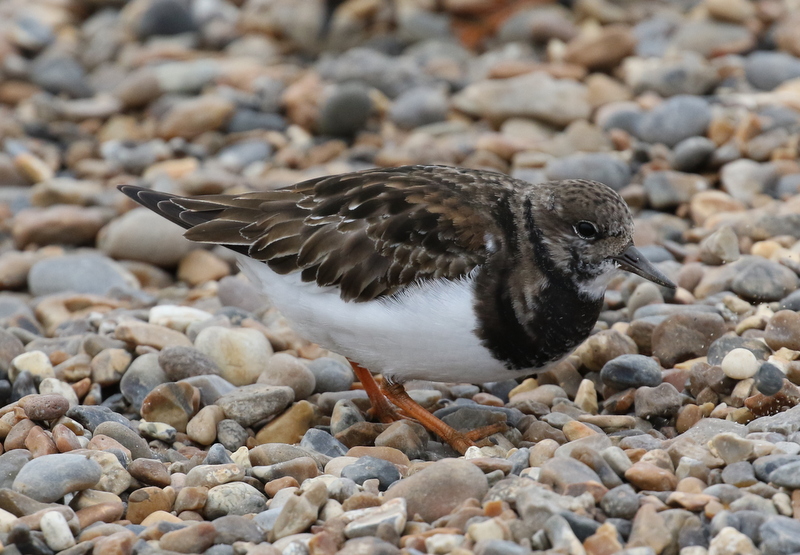 Turnstone – very tame, feeding by the Beach Road at Salthouse
Turnstone – very tame, feeding by the Beach Road at Salthouse
It was already time for lunch, but we still wanted to make one last stop at the Iron Road before heading back to the visitor centre at Cley. Rather than have lunch here, the group decided on a late lunch back at the visitor centre, so we set off straight away to see what we could find. The water level on the pool by Iron Road has gone down nicely and there was a good flock of Dunlin on here today. However, apart from a Redshank, we couldn’t immediately see anything else. With time pressing, we headed out along Attenborough’s Walk.
There were four Pink-footed Geese on the grazing marshes close to the path, which flew off as we passed. A little further along, we could see a large flock of Brent Geese. The vast majority were Dark-bellied Brents, as we would expect here, but a quick look at them and we found our second Pale-bellied Brent Goose of the day, right at the front of the flock.
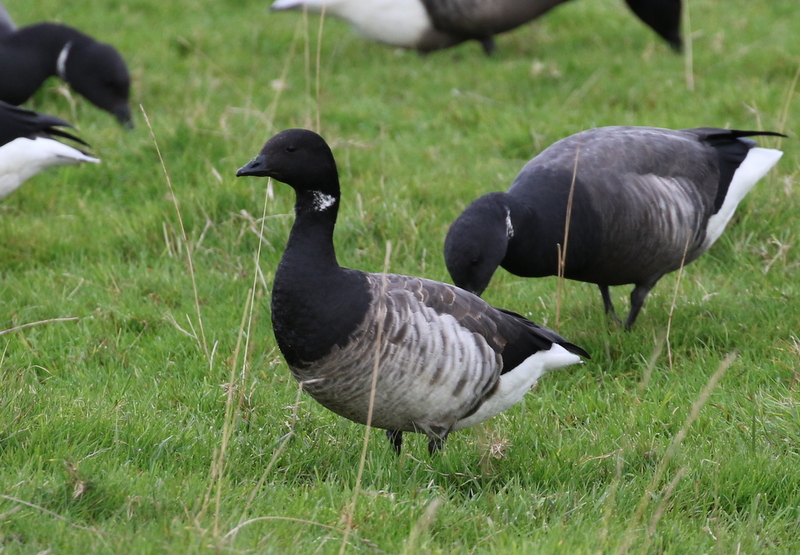 Pale-bellied Brent Goose – with Dark-bellied Brent behind for comparison
Pale-bellied Brent Goose – with Dark-bellied Brent behind for comparison
There were lots of Dunlin right in front of Babcock Hide but they were very nervous and kept flying round. A single Common Snipe, feeding on one of the islands nearby, took fright when they did so and landed much further back, out of sight in some taller vegetation. A single Ruff (or, more accurately, a female Reeve) was picking around on one of the islands further back, in amongst a large flock of sleeping Teal. Two Black-tailed Godwits were feeding up to their bellies in the deeper water.
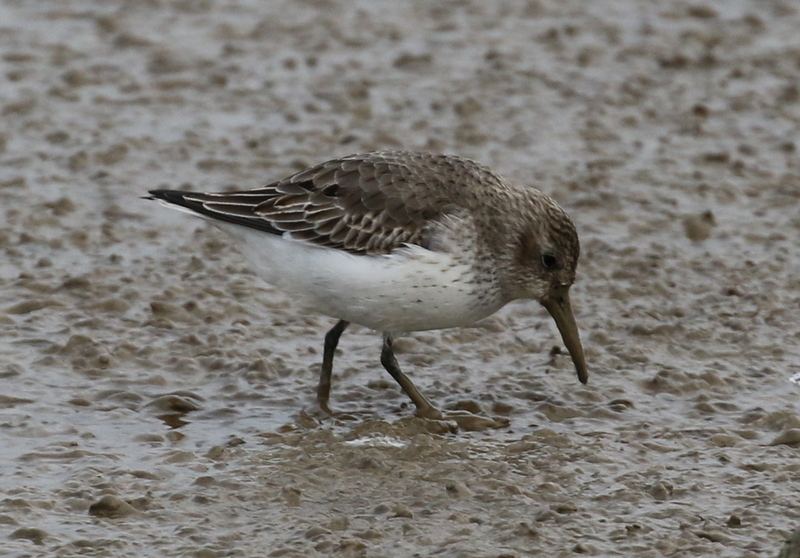 Dunlin – one of several feeding right in front of Babcock Hide
Dunlin – one of several feeding right in front of Babcock Hide
At first all we could see were dabbling ducks out on the water, but then one of group picked up a Long-tailed Duck which emerged from behind one of the reed islands in the deep water right at the back. It was diving constantly, but when it surfaced we could get a good look at it through the scope. We could see its white face with large dark brown cheek patch. Long-tailed Ducks are mostly found out on the sea in winter, where they dive for shellfish. Occasionally one may wander to an inland water for a short time, especially after gales. This one is unusual in that it has been on this small pool for over a month now. It must be finding something good to eat here!
We didn’t linger too long in Babcock Hide, and stopped only briefly on the walk back to the car to admire a pair of Stonechats on the fence. We made our way quickly back to the visitor centre for a late lunch. As it was so mild, we decided we would eat outside on the picnic tables, but we were only half way through when the weather turned. Some low cloud blew in and brought with it some misty drizzle, so we retreated to the car.
After lunch, we drove back west along the coast road to Stiffkey. We wanted to finish the day at the harrier roost, but with the weather having deteriorated we thought it best to watch from here today. When we arrived, we were told we had already missed a ringtail Hen Harrier and a Merlin – it seemed bird may have come in early tonight given the conditions.
As we stood and scanned the saltmarsh, a Brambling flew over calling and headed inland over the campsite. Looking away to the west, we picked up a distant grey male Hen Harrier flying low over the vegetation. Unfortunately, it dropped quickly down out of view, before everyone could get onto it. Then a second grey male appeared over in the same area, but it was even less obliging. The Hen Harriers were flying straight into the roost this evening, without flying round, probably due to the mist. Even when it temporarily brightened up a little, there was no sign of a pick-up in Hen Harrier activity.
The light was starting to go and we were just thinking our luck had run out when a large bird flew in from the fields behind us, just a short distance to our left. It was a ringtail Hen Harrier and we could see its white rump patch as it flew out across the saltmarsh, before disappearing out into the mist. That was a great way to end, so we called it a day and headed for home.
















